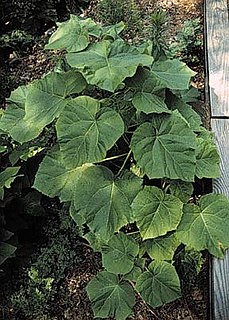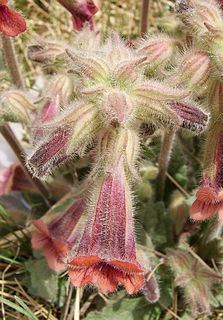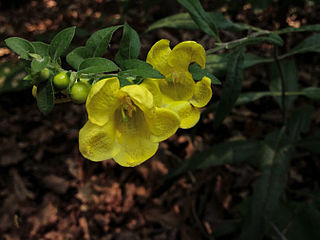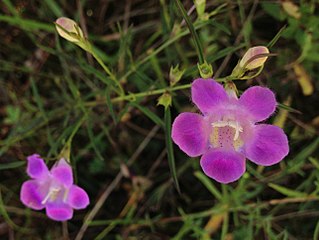
Paulowniaceae are a family of flowering plants within the Lamiales. They are a monophyletic and monogeneric family of trees with currently 7 confirmed species. They were formerly placed within Scrophulariaceae sensu lato, or as a segregate of the Bignoniaceae.

Rehmannia is a genus of seven species of flowering plants in the order Lamiales and family Orobanchaceae, endemic to China. It has been placed as the only member of the monotypic tribe Rehmannieae, but molecular phylogenetic studies suggest that it forms a clade with Triaenophora. Contrary to the immense majority of the taxa of Orobanchaceae, Rehmannia is not parasitic.

Agalinis is a genus of about 70 species in North, Central, and South America that until recently was aligned with members of the family Scrophulariaceae. As a result of numerous molecular phylogenetic studies based on various chloroplast DNA (cpDNA) loci, it was shown to be more closely related to members of the Orobanchaceae. Agalinis species are hemiparasitic, which is a character that in part describes the Orobanchaceae.

Agalinis aspera, the rough agalinis, rough false foxglove, or tall false foxglove, is a non-poisonous plant of the genus Agalinis, habitating in the dry prairies. It can grow to be about eight to twenty-four inches tall. When the flowers bloom, the colors vary between purple and pink.

Agalinis skinneriana is a species of flowering plant in the family Orobanchaceae known by the common names Skinner's gerardia, Skinner's false foxglove and pale false foxglove. It is native to North America, where it occurs in Ontario south to Missouri and Louisiana.

Aureolaria, with the common name false foxgloves, is a genus of 8 species, native to North America.

Rehmannia elata, the Chinese foxglove, is a species of flowering plant in the family Orobanchaceae, native to China. Growing to 150 cm (59 in) tall by 50 cm (20 in) broad, it is an herbaceous perennial with veined, hairy leaves and pink, tubular flowers with darker pink stripes in summer. The flowers bear a superficial resemblance to foxgloves, hence the common name "Chinese foxglove", which is also applied to the whole genus. However this species is not closely related to the true foxglove (Digitalis).
Toothwort is a common name for several plants and may refer to:

Aureolaria virginica, the downy yellow false foxglove or downy oak leach, is a perennial forb native to the eastern United States and Canada, which produces yellow flowers in summer.

Agalinis purpurea is an annual forb native to the eastern United States and Canada, which produces purple flowers in late summer or early fall.

Agalinis tenuifolia, known by the common names common gerardia, slender false foxglove or common false foxglove, is an annual forb native to the eastern and southwestern United States, and Canada, which produces purple flowers in late summer or early fall.

Aureolaria patula, commonly known as spreading yellow false foxglove or Cumberland oak-leach, is a species of plant in the family Orobanchaceae. It is native to the upper Southeastern United States, where it is found in Alabama, Georgia, Kentucky, and Tennessee. Due to its limited geographic range, this species in considered vulnerable, and is listed as rare in every state it is found. It is often found in populations consisting of only a few plants. Its habitat is rich alluvial forests and limestone slopes along major rivers.

Aureolaria pedicularia, the fernleaf yellow false foxglove, fern-leaved false foxglove, or fernleaf false foxglove, is a parasitic plant of the family Orobanchaceae. Aureolaria pedicularia is native to parts of the eastern US, the Midwest, and adjacent Canada. This plant is known for its distinct leaf shape and overall plant size. The common names for Aureolaria pedicularia come from its fern-like leaves.

Aureolaria levigata, commonly known as entireleaf yellow false foxglove or Appalachian oak-leech, is a species of flowering plant in the family Orobanchaceae. It is native to much of the Appalachian Mountains and surrounding areas in the eastern United States. It is also found in a disjunct population in southwestern Mississippi.
Agalinis divaricata is a flowering plant species in the genus Agalinis. It is commonly known as pineland false foxglove. A dicot, it grows in parts of Florida, Georgia and Alabama. It is in the Orobanchaceae (broomrape) family. It grows in dry longleaf pine forests and savannahs. The genus is hemiparasitic.
Lamourouxia may refer to:
This page is based on this
Wikipedia article Text is available under the
CC BY-SA 4.0 license; additional terms may apply.
Images, videos and audio are available under their respective licenses.











